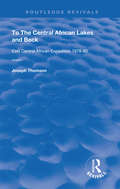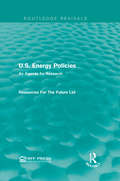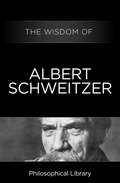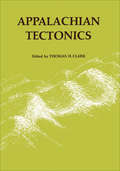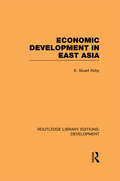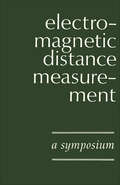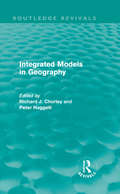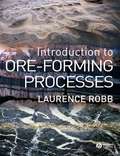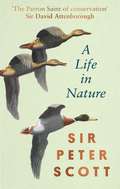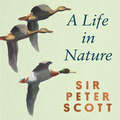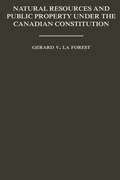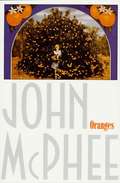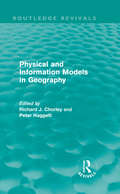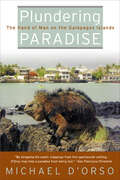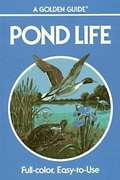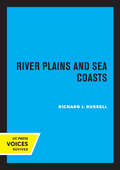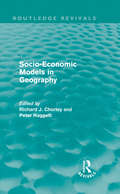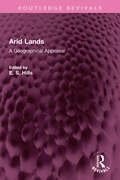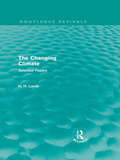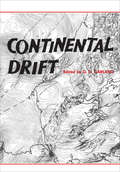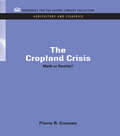- Table View
- List View
To The Central African Lakes and Back: The Narrative of The Royal Geographical Society's East Central Expedition 1878-80, Volume 1 (Routledge Revivals)
by Joseph ThompsonFirst published in 1968: This, the record of the author's first journey into the interior of Africa, established his credentials as an explorer of the first rank. Although he made no startling discoveries and his experiences lack the dramatic impact of those retailed in Through Masai Land, his more widely known and subsequent narrative, To The Central African Lakes added measurably to Europe's knowledge of a part of eastern Africa which hitherto had only been understood in imperfect outline.
U.S. Energy Policies: An Agenda for Research (Routledge Revivals)
by Resources For The Future LtdU.S. Energy Policies, first published in 1968, aims to assemble and describe within an overall framework the energy policy questions that RRF believed would profit from study and analysis. This study covers the past performance and trends in the energy industries, the nature of existing industries and of the government policies bearing on them, and the effects of those policies. This title also takes note of the prospective influence of economic and technological developments and evaluates the probable effects of selected alternatives to existing policies. This book will be of interest to students of environmental studies.
Why Frogs Are Wet (Let's-Read-and-Find-Out Science 2)
by Judy HawesRead and find out about frogs in this colorfully illustrated nonfiction picture book.Frogs can jump thirty times their own body length, catch insects on the wing, and breathe underwater or on land. But they must always keep their skins wet. Read and find out why! This is a clear and appealing science book for early elementary age kids, both at home and in the classroom. It's a Level 2 Let's-Read-and-Find-Out, which means the book explores more challenging concepts for children in the primary grades. The 100+ titles in this leading nonfiction series are:hands-on and visualacclaimed and trustedgreat for classroomsTop 10 reasons to love LRFOs:Entertain and educate at the same timeHave appealing, child-centered topicsDevelopmentally appropriate for emerging readersFocused; answering questions instead of using survey approachEmploy engaging picture book quality illustrationsUse simple charts and graphics to improve visual literacy skillsFeature hands-on activities to engage young scientistsMeet national science education standardsWritten/illustrated by award-winning authors/illustrators & vetted by an expert in the fieldOver 130 titles in print, meeting a wide range of kids' scientific interestsBooks in this series support the Common Core Learning Standards, Next Generation Science Standards, and the Science, Technology, Engineering, and Math (STEM) standards. Let's-Read-and-Find-Out is the winner of the American Association for the Advancement of Science/Subaru Science Books & Films Prize for Outstanding Science Series.
The Wisdom of Albert Schweitzer (Wisdom)
by The Wisdom SeriesReverence for Life—Albert Schweitzer&’s pivotal philosophyMusician, physician, humanitarian, and philosopher, Albert Schweitzer was a twentieth-century Renaissance man who won the Nobel Peace Prize for his &“Reverence for Life&” philosophy. The Wisdom of Albert Schweitzer explores this core philosophy, which inspired one of the world&’s great humanitarians. While traveling in Africa, Schweitzer recognized that all living creatures have a will to live and believed that through a &“reverence for life&” mankind had an ethical imperative to aid in the welfare of all living things, including the environment. His words have remained an inspiration for generations of humanitarians and environmentalists.
The Wisdom of Albert Schweitzer (Wisdom)
by The Wisdom SeriesReverence for Life—Albert Schweitzer&’s pivotal philosophyMusician, physician, humanitarian, and philosopher, Albert Schweitzer was a twentieth-century Renaissance man who won the Nobel Peace Prize for his &“Reverence for Life&” philosophy. The Wisdom of Albert Schweitzer explores this core philosophy, which inspired one of the world&’s great humanitarians. While traveling in Africa, Schweitzer recognized that all living creatures have a will to live and believed that through a &“reverence for life&” mankind had an ethical imperative to aid in the welfare of all living things, including the environment. His words have remained an inspiration for generations of humanitarians and environmentalists.
Appalachian Tectonics (The Royal Society of Canada #No. 10)
by Thomas H. ClarkMountain ranges are the most conspicuous elements of the earth's architecture, and the manner in which the architectural units are arranged or disarranged has become the study of a subdivision of geology known as Tectonics. A hundred years ago James Hall attempted the first scientific synthesis of the steps in the building of the eastern North American mountains, the Appalachians. His initial hypothesis of 1857, expanded and broadened by J.D. Dana during the decade which followed, laid the foundation for our modern geosynclinal theory of mountain building. During the last century of modifications and refinements were contributed concerning the roles played by crustal compression, sub-crustal convection currents, batholiths, metamorphism, gravity sliding, and isostasy. In recent years detailed mapping, supplemented by studies of turbidity currents, paleomagentism, stable isotopes, and radio-activity have helped to unravel the history of mountain building, but today there are as many questions unanswered as there are those for which there are tentative solutions.<P><P>Aspects of Appalachian orogeny was a suitable subject for the symposium of the Royal Society of Canada Annual Meeting in 1966 at Sherbrooke, Quebec—a city within the Appalachian Mountain System. This book assembles the papers of this symposium, dealing with gravity sliding, studies of sedimentation and structure in limited areas, comparisons with the Appalachians of the United States, the bearing of gravity measurements upon our understanding of mountain structure, earthquakes, and a broad, general view of the tectonic pattern of the earth of which this mountain-built belt is but a small part.<P>Such a comprehensive volume, bringing together a variety of points of view of some of the foremost scholars in the field, indicates the vastness of the subject, the significant progress made thus far, the necessity for new and progressive methods of exploration, and above all the interdependence of all the workers in the field, no matter how seemingly unrelated their specialties are.
Economic Development in East Asia (Routledge Library Editions: Development)
by E. Stuart KirbyFirst published in 1967, this influential study reviews the economic development of 15 countries from East Asia in the period between 1945 and 1965. It deals with a wide variety of factors influencing the development of the region, including the influence of foreign governments (both international aid and foreign trade); population development; industrialisation; transport and communication infrastructure; and the impact of economic development upon the population of East Asia.
Electromagnetic Distance Measurement
by International Association of GeodesyElectromagnetic distance measurement, by using light and microwaves for direct linear measurements and thus circumventing the need for traditional methods of triangulation, may well introduce a new era in surveying. This book brings together the work of forty-eight geodesists from twenty-five countries. They discuss various new EDM instruments—among them the Tellurometer, Geodimeter, and air- and satellite-borne systems—and investigate the complex sources of error. The book is therefore a unique and comprehensive source on the subject. UNESCO and R.I.C.S. have assisted financially in its production.
Integrated Models in Geography (Routledge Revivals)
by Richard J. Chorley Peter HaggettFirst published in 1967, this book explores the theme of geographical generalization, or model building. It is composed of five of the chapters from the original Models in Geography, published in 1967. The first chapter broadly outlines this theme and examines the nature and function of generalized statements, ranging from conceptual models to scale models, in a geographical context. The following chapters deal with mixed-system model building in geography, wherein data, techniques and concepts in both physical and human geography are integrated. The book contains chapters on organisms and ecosystems as geographical models as well as spatial patterns in human geography. This text represents a robustly anti-idiographic statement of modern work in one of the major branches of geography.
Introduction to Ore-Forming Processes
by Laurence RobbIntroduction to Ore-Forming Processes is the first senior undergraduate - postgraduate textbook to focus specifically on the multiplicity of geological processes that result in the formation of mineral deposits. Opens with an overview of magmatic ore-forming processes Moves systematically through hydrothermal and sedimentary metallogenic environments, covering as it does the entire gamut of mineral deposit types, including the fossil fuels and supergene ores The final chapter relates metallogeny to global tectonics by examining the distribution of mineral deposits in space and time Boxed examples of world famous ore deposits are featured throughout providing context and relevance to the process-oriented descriptions of ore genesis Brings the discipline of economic geology back into the realm of conventional mainstream earth science by emphasizing the fact that mineral deposits are simply one of the many natural wonders of geological process and evolution. Artwork from the book is available to instructors at www.blackwellpublishing.com/robb.
A Life In Nature
by Peter Scott'The Patron Saint of Conservation' Sir David Attenborough'Peter Scott was a huge influence on my childhood...Later on in life I had the good fortune both to meet and to interview him, and he remains, for me, a hero. His knowledge, his kindness to me and his generosity of spirit have remained an influence in my own sphere of natural history....To meet one's heroes can sometimes be a let-down. That was most certainly not the case with Peter Scott.' Alan TitchmarshA Life In Nature is a portrait of Peter Scott collected from his own conversations, articles and broadcasts including thoughts on expeditions to Lapland, Conservation and Africa, his travels in Europe and much more. Illustrated by Peter's own beautiful illustrations. Sir Peter Scott had a truly incredible life. He was the only son of legendary explorer Captain Scott. His godfather was JM Barrie and he was married to Elizabeth Jane Howard. He also represented Great Britain and Northern Ireland at sailing in the 1936 Berlin Olympic Games, winning a bronze medal. He founded the Wildfowl and Wetlands Trust and also helped to found the Worldwide Fund for Nature.This is a beautiful and timely re-discovered book, perfect for those who are interested in preserving our planet.
A Life In Nature
by Sir Peter Scott'The Patron Saint of Conservation' Sir David Attenborough'Peter Scott was a huge influence on my childhood...Later on in life I had the good fortune both to meet and to interview him, and he remains, for me, a hero. His knowledge, his kindness to me and his generosity of spirit have remained an influence in my own sphere of natural history....To meet one's heroes can sometimes be a let-down. That was most certainly not the case with Peter Scott.' Alan TitchmarshA Life In Nature is a portrait of Peter Scott collected from his own conversations, articles and broadcasts including thoughts on expeditions to Lapland, Conservation and Africa, his travels in Europe and much more. Illustrated by Peter's own beautiful illustrations. Sir Peter Scott had a truly incredible life. He was the only son of legendary explorer Captain Scott. His godfather was JM Barrie and he was married to Elizabeth Jane Howard. He also represented Great Britain and Northern Ireland at sailing in the 1936 Berlin Olympic Games, winning a bronze medal. He founded the Wildfowl and Wetlands Trust and also helped to found the Worldwide Fund for Nature.This is a beautiful and timely re-discovered book, perfect for those who are interested in preserving our planet.
A Life In Nature
by Sir Peter Scott'The Patron Saint of Conservation' Sir David Attenborough'Peter Scott was a huge influence on my childhood...Later on in life I had the good fortune both to meet and to interview him, and he remains, for me, a hero. His knowledge, his kindness to me and his generosity of spirit have remained an influence in my own sphere of natural history....To meet one's heroes can sometimes be a let-down. That was most certainly not the case with Peter Scott.' Alan TitchmarshA Life In Nature is a portrait of Peter Scott collected from his own conversations, articles and broadcasts including thoughts on expeditions to Lapland, Conservation and Africa, his travels in Europe and much more. Illustrated by Peter's own beautiful illustrations. Sir Peter Scott had a truly incredible life. He was the only son of legendary explorer Captain Scott. His godfather was JM Barrie and he was married to Elizabeth Jane Howard. He also represented Great Britain and Northern Ireland at sailing in the 1936 Berlin Olympic Games, winning a bronze medal. He founded the Wildfowl and Wetlands Trust and also helped to found the Worldwide Fund for Nature.This is a beautiful and timely re-discovered book, perfect for those who are interested in preserving our planet.
Natural Resources and Public Property Under the Canadian Constitution (The Royal Society of Canada Special Publications)
by Gerard La ForestThe controversy aroused by the Supreme Court's decision on offshore mineral rights emphsizes the importance of the public domain in the workings of the Canadian constitution. Public property is important to the provinces not only for its revenues, but also because it provides them with a powerful instrument for control of their economic and political destinies and strengthens their position in relation to federal authorities. The provisions of the British North America Act and other constitutional instruments relating to natural resources and public property are examined thoroughly in this series of lectures given to doctoral systems at the Faulte de droit of the Universite de Montreal. Professor La Forest studies ownership of mines and minerals, navigable waters, public harbours, fisheries and Indian lands, as well as the currently controversial offshore mineral rights. He notes the political imlications of the partition of proprietary rights and explores the areas of conflict between the federal and provincial governments. Also included is a discussion of the power of expropriation, and, because public property involves public monies, lending and spending powers receive attention.In these lectures, Professor La Forest traces public domain in Britain from the time when the monarch controlled all the land, to his surrender of this control to parliament in return for a civil list, and to the similar surrender to the legislatures of the British North American colonies in connection with the struggle of responsible government.The collection of lectures is essential reading for any serious student of the constitution and will be very useful to all who are interested in the increasingly important law of natural resources in Canada.
Oranges
by John McpheeA classic of reportage, Oranges was first conceived as a short magazine article about oranges and orange juice, but the author kept encountering so much irresistible information that he eventually found that he had in fact written a book. It contains sketches of orange growers, orange botanists, orange pickers, orange packers, early settlers on Florida’s Indian River, the first orange barons, modern concentrate makers, and a fascinating profile of Ben Hill Griffin of Frostproof, Florida who may be the last of the individual orange barons. McPhee’s astonishing book has an almost narrative progression, is immensely readable, and is frequently amusing. Louis XIV hung tapestries of oranges in the halls of Versailles, because oranges and orange trees were the symbols of his nature and his reign. This book, in a sense, is a tapestry of oranges, too--with elements in it that range from the great orangeries of European monarchs to a custom of people in the modern Caribbean who split oranges and clean floors with them, one half in each hand.
Physical and Information Models in Geography (Routledge Revivals)
by Richard J. Chorley Peter HaggettFirst published in 1967, this book explores the theme of geographical generalization, or model building. It is composed of eight of the chapters from the original Models in Geography, published in 1967. The first chapter broadly outlines geographical generalization and examines the nature and function of generalized statements, ranging from conceptual models to scale models, in a geographical context. The following chapter deals with model theory in a wider scientific framework and the rest of the book discusses models of physical systems and information models. The book considers model-type generalizations that are applied in the three fields of geomorphology, meteorology and climatology, and hydrology before focusing on the transference of information and ideas in geography. This text represents a robustly anti-idiographic statement of modern work in one of the major branches of geography.
Plundering Paradise: The Hand of Man on the Galapagos Islands
by Michael D'OrsoMention the Galápagos Islands to almost anyone, and the first things that spring to mind are iguanas, tortoises, volcanic beaches, and, of course, Charles Darwin. But there are people living there, too -- nearly 20,000 of them. A wild stew of nomads and grifters, dreamers and hermits, wealthy tour operators and desperately poor South American refugees, these inhabitants have brought crime, crowding, poaching, and pollution to the once-idyllic islands. In Plundering Paradise, Michael D'Orso explores the conflicts on land and at sea that now threaten to destroy this fabled "Eden of Evolution."
Pond Life
by George Reid Herbert Zim Sally Kaicher Tom DolanA handbook describing and illustrating some of the common animals and plants found in or near ponds, lakes, streams, and marshes.
River Plains and Sea Coasts
by Richard J. RussellThis title is part of UC Press's Voices Revived program, which commemorates University of California Press’s mission to seek out and cultivate the brightest minds and give them voice, reach, and impact. Drawing on a backlist dating to 1893, Voices Revived makes high-quality, peer-reviewed scholarship accessible once again using print-on-demand technology. This title was originally published in 1967.
Socio-Economic Models in Geography (Routledge Revivals)
by Richard J. Chorley and Peter HaggettFirst published in 1968, this book explores the theme of geographical generalization, or model building. It is composed of seven of the chapters from the original Models in Geography, published in 1967. The first chapter broadly outlines this theme and examines the nature and function of generalized statements, ranging from conceptual models to scale models, in a geographical context. The following six chapters deal with socio-economic building in geography. They focus on demographic and sociological models as well as looking at special aspects of models in human geography in reference to economic development, urban geography and settlement location, industrial location, and agricultural activity. This book represents a robustly anti-idiographic statement of modern work in one of the major branches of geography.
Waves
by Herbert S. ZimThis book talks about anything you ever wanted to know about waves, from how they are formed, explaining simple vocabulary about waves, how they travel across the oceans, how they can be destructive, and how they can be useful too. Although this book was published in 1967 I found it had some excellent information on a topic not often talked about, Ocean waves. Good read in my opinion.
Arid Lands: A Geographical Appriasal (Routledge Revivals)
by E. S. HillsIn 1951 UNESCO launched an Arid Zone Programme with the object of promoting research into arid regions from every relevant scientific point of view. This book, originally published in 1966, represents the range of research undertaken and gives a general conspectus of arid zone geography. 17 authors from 8 countries contributed and the book deals comprehensively with all the main areas, with specific examples used to illustrate arguments. There are chapters on meteorology, geology, geomorphology, botany and zoology and almost 50% of the book is devoted to man’s activities: irrigation and agriculture; industry; animal breeding and human survival in the desert
The Changing Climate: Selected Papers (Routledge Revivals: A History of Climate Changes)
by H. H. LambFirst published in 1966 these collected papers, written by the distinguished and visionary climatologist Hubert H. Lamb, describe how climates come about and give a history of climatic changes from the last ice-age to the 1960s.
Continental Drift
by G. D. GarlandThe possibility that the continents of the earth have undergone major changes in position during the earth's history has fascinated scholars for at least three hundred years. Recently, evidence from several scientific disciplines has shown that the possibility must be very seriously considered in any study of the surface features of the earth. The first part of this volume consists of papers given at a symposium on continental drift, held at the annual meeting of the Royal Society of Canada in Charlottetown in June 1964. They present the views of three geophysicists, a botanist, and an astronomer. In these papers, the present evidence for or against continental drift is reviewed and the authors in most cases draw their own conclusions. The reader will find that there is not unanimous agreement in favour of drift. Nearly all discussions of continental drift stress the possible separation of the Americas from Europe and Africa. Considerable work has been done on the tracing of structures, on each side of the Atlantic Ocean, which might once have been connected. Geologists and geophysicists working in the Arctic or on the eastern seaboard of Canada have an important contribution to make to this subject. The second part of this volume, therefore, consists of a group of papers, also presented at the Charlottetown meeting, which throw light on the complicated crustal structure of these regions. In any attempt to reconstruct North America as part of Europe the features described in these papers will have to be taken into account. Once again, the reader will find differences of opinion on the question of whether the evidence favours a separation of our continent from Europe. Indeed, it is because the theory of continental drift us so difficult to confirm without ambiguity by direct observation that it remains controversial but exciting.
The Cropland Crisis: Myth or Reality? (RFF Agriculture and Fisheries Set)
by Pierre CrossonThis book examines the factors affecting the demand for agricultural land in the United States and the costs of meeting increasing demand. Originally published in 1982
